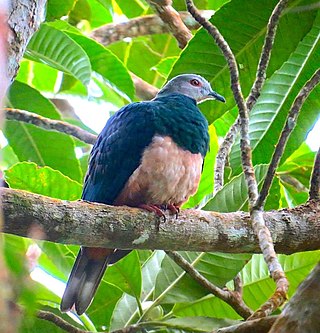
The pink-bellied imperial pigeon, also known as the zone-tailed pigeon, is found in the Philippines. It is a large and striking dove reaching sizes of up to 42cm long. The pink-bellied imperial pigeon is mostly dark green, with a pale gray head, an appropriately pink belly, and a brown, black, and gray pattern on its tail. Its eyes and eye ceres are red. Its natural habitat is tropical moist lowland forest. It is threatened by habitat loss.
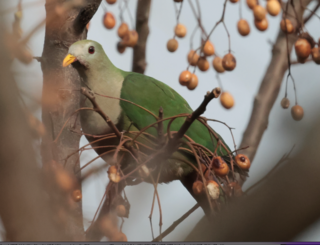
The black-chinned fruit dove, also known as the black-throated fruit dove or Leclancher's dove. It is found in the lowland forests of the Philippines and Taiwan.

The Philippine megapode, also known as the Philippine scrubfowl or the Tabon scrubfowl, is a species of bird in the family Megapodiidae. It is found in the Philippines, northeastern Borneo, and Sulawesi. It has a wide range of natural habitats which include tropical dry forest, tropical moist lowland forest, tropical moist montane forest and small islands. The species was named after the collector Hugh Cuming.
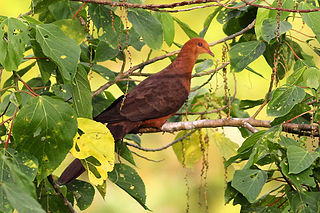
The Philippine cuckoo-dove is a species of bird in the family Columbidae. It is found in the Philippines and Taiwan and is rated as a species of least concern on the International Union for Conservation of Nature Red List of Endangered Species.

Brown doves are members of the genus Phapitreron in the pigeon family. Their common name refers to their overall brown coloration. They are endemic to the Philippines. All brown doves are tree-dwellers, but the different species occupy different types of wooded habitats; some are more restricted to old-growth forest while other make use of secondary forest and other woodland. Their main diet is fruit. They tend to be solitary in their habits and can be elusive. Some species in this genus have conspicuous black and white stripes on their faces and iridescent neck feathers. Males and females look alike.

The Mindanao brown dove is a threatened species of bird in the family Columbidae. It is endemic to forests on the Philippine islands of Mindanao and Basilan, but it has not been recorded from the latter island since 1937. It is threatened by habitat loss and hunting. Until recently, it was considered conspecific with the Tawitawi brown dove and collectively called the dark-eared brown dove.
The Tawitawi brown dove, also dark-eared brown dove, is a threatened species of bird in the family Columbidae noted for its orange-peach breast. It is endemic to forests in the Sulu Archipelago in the Philippines. Until recently it was considered conspecific with the Mindanao brown dove and collectively called the dark-eared brown dove. Although threatened by habitat loss, the rate of loss significantly reduced from 2004 to 2007, and it was thus downlisted from Critically Endangered to Endangered status in the 2007 IUCN Red List.

The white-eared brown dove is a species of bird in the family Columbidae. It is endemic to the Philippines, and is most commonly found in lowland and montane forests.

The cream-breasted fruit dove or cream-bellied fruit dove is a species of bird in the family Columbidae. It is a large and primarily greenish dove with a distinctive red wing patch and cream coloured breast which it was named after. It is endemic to the Philippines found only on the islands of Luzon, Catanduanes and Polillo Islands. Its natural habitat is tropical moist lowland to montane forests of up to 1,300 masl. It is threatened by habitat loss, and trapping for the pet trade.
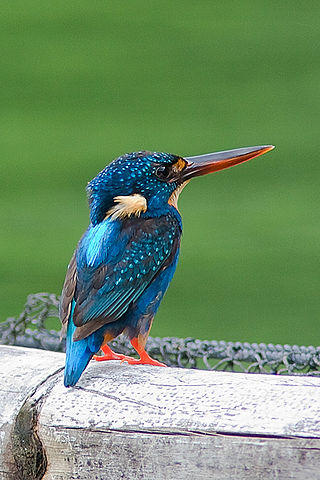
The Indigo-banded kingfisher is a species of bird in the family Alcedinidae. It is endemic to the Philippines found on the islands of Luzon, Mindoro, Masbate and the Western Visayas region
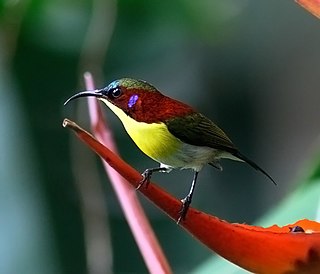
The handsome sunbird is a species of bird in the family Nectariniidae. It is endemic to the Philippines.

The Black shama is a species of bird in the family Muscicapidae. It is endemic to the island of Cebu, Philippines where it is known locally as "Siloy".
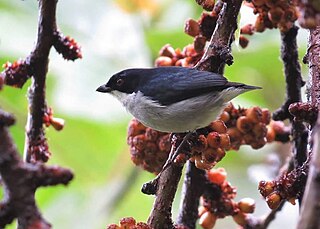
The bicolored flowerpecker is a species of bird in the family Dicaeidae. It is endemic to the Philippines.

The pygmy flowerpecker is a species of bird in the family Dicaeidae. It is endemic to the Philippines.

The balicassiao is a species of passerine bird in the family Dicruridae. It is endemic to the Philippines. Its natural habitat is tropical moist lowland forests.
The Negros scops owl, also known as the Visayan scops owl, is an owl, endemic to the islands of Negros and Panay in the Philippines, belonging to the family of the typical owls Strigidae. It has a distinct and striking rufous or reddish brown crown, nape and face. It was formerly classified as a subspecies of the Philippine scops owl. It is threatened by habitat loss and hunting for the pet trade.

The Mindoro boobook or Mindoro hawk-owl is a species of owl in the family Strigidae that is endemic to the Philippines.

The Cebu boobook or Cebu hawk-owl is a species of owl in the family Strigidae. It is endemic to the Philippines. It was formerly considered a subspecies of the Philippine hawk-owl, but was reclassified in 2012, as voice and other data suggested placement in a distinct species.

The Sulu boobook or Sulu hawk-owl is a species of owl in the family Strigidae. It is endemic to the Sulu Archipelago in the Philippines. It was previously known as a subspecies of the Philippine hawk-owl, but was reclassified in 2012, as voice and other evidence suggested it was a distinct species. It is found in tropical moist lowland forest. It is threatened by habitat loss.
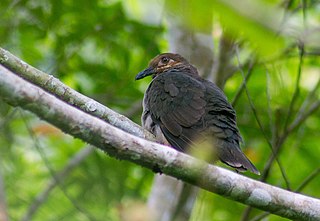
The grey-breasted brown dove is a subspecies of amethyst brown dove in the family Columbidae. It is endemic to the Philippines being found in Negros and Panay. Its natural habitats are or tropical moist lowland forests and tropical moist montane forests. It is found in lowlands but probably prefers middle and high elevations at 500-2000m. It is most often seen singly or in pairs, in and around fruiting trees. The call is a deep, sonorous "hoot-hoot-hoot-hoot", and birds may sit and call for long periods.



















